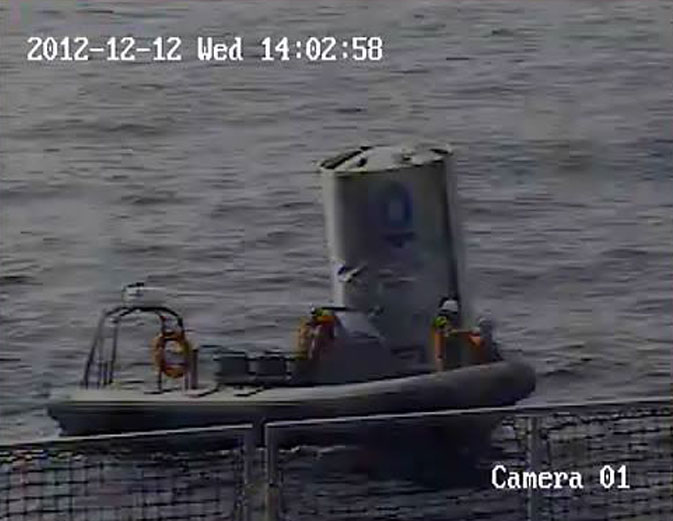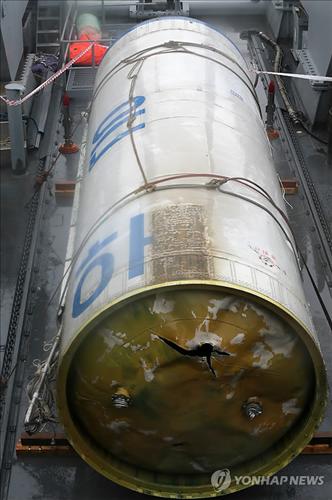-14.12.2012 / 9.45 MEZ

S. Korea retrieves N. Korean rocket's debris in Yellow Sea
SEOUL, Dec. 14 (Yonhap) -- The Navy has retrieved the debris of North Korea's long-range rocket launched earlier this week, the defense ministry said Friday, which would give a glimpse of the communist state's rocket technology.
Less than two hours after Wednesday's liftoff, a South Korean Aegis destroyer deployed in the Yellow Sea discovered an object, believed to be part of a fuel container from the first stage of the rocket, near the trajectory announced by the North.
"The Navy's Deep Submergence Rescue Vehicle retrieved the debris of the rocket's first stage at 00:26 a.m. and was delivering it to the Second Command Fleet in Pyeongtaek," west of Seoul, a ministry official said.
The first stage of the North's Unha-3 rocket fell in the sea off the Korean Peninsula, while the second landed east of the Philippines.
After the Navy first discovered the object on the launch day in waters about 160 kilometers west of Gunsan in Jeolla Province and about 430 km south of the North's launch site, a rigid inflatable boat (RIB) attached a dragline to the debris.
The object started to submerge at around 4 p.m. on that day at a depth around 80 meters.
The salvage operation started at 4 p.m. Thursday and succeeded in retrieving the 7.6-meter-long, 2.4-diameter object, which is inscribed with the word "Unha," the rocket's name, after eight hours of work, the ministry said.
The chunk of debris is expected to arrive at the Pyeongtaek port at about 11 a.m. for further analysis by military officials and rocket scientists, the ministry said.
"It is expected to become a useful material for analysis of North Korean rocket's technology," ministry spokesman Kim Min-seok said.
When Pyongyang's last attempt in April ended in failure after the rocket flamed out shortly after liftoff, it was smashed into about 20 pieces.
Although North Korea claims the launch was meant to send a satellite into space, South Korea, U.S. and other nations consider it as a covert test for ballistic missile technology banned by the United Nations for its past missile and nuclear tests.
-
Update: 14.12.2012 / 16.30 MEZ

South Korea's Navy has retrieved the debris of North Korea's long-range rocket launched earlier this week and a joint investigation team will analyze it to get a glimpse of the communist state's rocket technology, the defense ministry here said Friday.
Less than two hours after Wednesday's liftoff, a South Korean Aegis destroyer deployed in the Yellow Sea discovered an object, believed to be part of a fuel container from the first stage of the rocket, near the trajectory announced by the North.
A deep submergence rescue ship retrieved the debris at 00:26 a.m. and delivered it to the Second Command Fleet in Pyeongtaek, south of Seoul, at around noon.
"As the tides have been getting higher due to strong wind, we accelerated the salvage operation," Navy Captain Jye Byung-ryeol told reporters, on board the 3,200-ton ship equipped with sonar systems.
The 3.2-ton upper part of the first stage, which was inscribed with the rocket's name "Unha," was lying on the Cheong Hae Jin ship, with a bundle of wires on the surface of the container.
The 7.6-meter-long, 2.4-diameter object had four holes on the bottom, which are believed to be used to connect engines, and it remained mostly intact.
Reporters were allowed to observe the debris on board the ship upon its arrival, but were banned from touching the object as it could have oxidizer on the surface.
It was not immediately known what kinds of materials were used to build the rocket body.
After conducting an initial inspection, it will be delivered to the Agency for Defense Development (ADD) in Daejeon, about 164 kilometers south of Seoul, later in the day for further analysis by military officials and missile experts, the defense ministry said.
"The debris of the first stage rocket doesn't have engines," ministry spokesman Kim Min-seok said in a briefing. "Although North Korea has fired off missiles, it has never left debris. So, it's going to be an important material to study (the North's) missile capability."
As soon as it is delivered, a joint investigation team composed of military officials, rocket and missile scientists of the aero space and weapons development agencies will look into the debris, Kim said.
According to a senior military official, American experts, who have expertise in analyzing missiles developed by the Soviet Union and Iran, will also participate in the investigation. It was not yet known who will join the team.
An in-depth analysis is expected to determine the fuel component, its capacity, rocket's material and thrust technology, Kim said.
The North is known to have used solid fuel for its rockets, but its specific materials have not been unveiled to the outside world.
As the rocket engine is fitted with four booster engines of the Nodong-B ballistic missile, the analysis would provide knowledge of the shorter-range missile launched from Musudan-ri in its northeast in April 2009, experts say.
When Pyongyang's last attempt in April ended in failure after the rocket flamed out shortly after liftoff, it was smashed into about 20 pieces.
Minutes after the Wednesday liftoff, the first stage of the North's Unha-3 rocket fell in the sea off the Korean Peninsula, while the second landed east of the Philippines.
After the Navy first discovered the object on the launch day in waters about 160 kilometers west of Gunsan in Jeolla Province and about 430 km south of the North's launch site, a rigid inflatable boat (RIB) attached a dragline to the debris.
The object started to submerge at around 4 p.m. on that day at a depth around 80 meters.
The salvage operation started at 4 p.m. Thursday and succeeded in retrieving the object after eight hours of work.
Although North Korea claims the launch was meant to send a satellite into space, South Korea, U.S. and other nations consider it as a covert test for ballistic missile technology banned by the United Nations for its past missile and nuclear tests.
5515 Views

